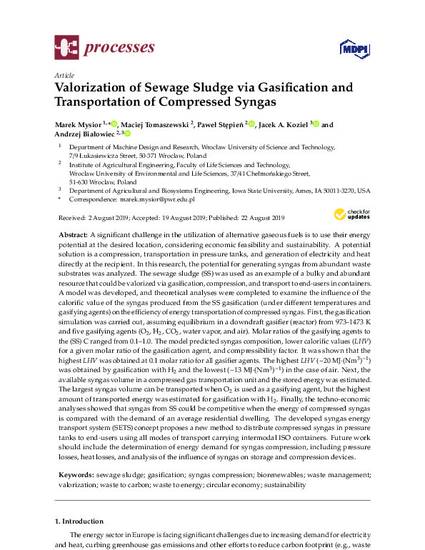
A significant challenge in the utilization of alternative gaseous fuels is to use their energy potential at the desired location, considering economic feasibility and sustainability. A potential solution is a compression, transportation in pressure tanks, and generation of electricity and heat directly at the recipient. In this research, the potential for generating syngas from abundant waste substrates was analyzed. The sewage sludge (SS) was used as an example of a bulky and abundant resource that could be valorized via gasification, compression, and transport to end-users in containers. A model was developed, and theoretical analyses were completed to examine the influence of the calorific value of the syngas produced from the SS gasification (under different temperatures and gasifying agents) on the efficiency of energy transportation of compressed syngas. First, the gasification simulation was carried out, assuming equilibrium in a downdraft gasifier (reactor) from 973–1473 K and five gasifying agents (O2, H2, CO2, water vapor, and air). Molar ratios of the gasifying agents to the (SS) C ranged from 0.1–1.0. The model predicted syngas composition, lower calorific values (LHV) for a given molar ratio of the gasification agent, and compressibility factor. It was shown that the highest LHV was obtained at 0.1 molar ratio for all gasifier agents. The highest LHV (~20 MJ∙(Nm3)−1) was obtained by gasification with H2 and the lowest (~13 MJ∙(Nm3)−1) in the case of air. Next, the available syngas volume in a compressed gas transportation unit and the stored energy was estimated. The largest syngas volume can be transported when O2 is used as a gasifying agent, but the highest amount of transported energy was estimated for gasification with H2. Finally, the techno-economic analyses showed that syngas from SS could be competitive when the energy of compressed syngas is compared with the demand of an average residential dwelling. The developed syngas energy transport system (SETS) concept proposes a new method to distribute compressed syngas in pressure tanks to end-users using all modes of transport carrying intermodal ISO containers. Future work should include the determination of energy demand for syngas compression, including pressure losses, heat losses, and analysis of the influence of syngas on storage and compression devices.
Available at: http://works.bepress.com/jacek_koziel/283/

This article is published as Mysior, Marek, Maciej Tomaszewski, Paweł Stępień, Jacek A. Koziel, and Andrzej Białowiec. "Valorization of Sewage Sludge via Gasification and Transportation of Compressed Syngas." Processes 7, no. 9 (2019): 556. DOI: 10.3390/pr7090556. Posted with permission.